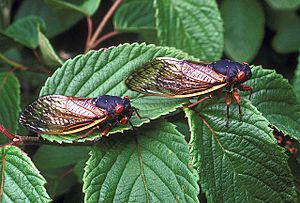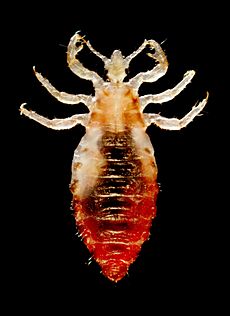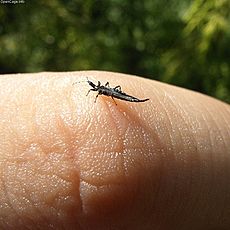Parapneuroptera facts for kids
Quick facts for kids Parapneuroptera |
|
|---|---|
 |
|
| Magicicada septendecim, a cicada (Hemiptera) | |
| Scientific classification | |
| Kingdom: | |
| Phylum: | |
| Class: | |
| Subclass: | |
| Infraclass: | |
| Superorder: |
Paraneoptera
|
| Orders | |
|
Psocoptera – bark lice Phtiraptera – lice Thysanoptera – thrips Hemiptera – true bugs |
|
Imagine a special group of insects called Paraneoptera. They are like a big family because they all share a common ancestor. This group includes four main types of insects: bark lice, true lice, thrips, and true bugs.
These insects have different ways of eating. Some of the older types munch on tiny microbes found on surfaces. But others, like the more modern ones, use special mouthparts to suck up liquids from plants or even animals!
Contents
Meet the True Bugs (Hemiptera)
Let's meet the Hemiptera, also known as the true bugs. This group is huge! There are about 50,000 to 80,000 different kinds of true bugs. You might know some of them, like cicadas, aphids, planthoppers, leafhoppers, and shield bugs.
True bugs come in many sizes, from super tiny (about 1 millimeter) to quite large (around 15 centimeters). What makes them all "true bugs" is their special mouthparts. They all have a unique way of sucking up their food.
Discovering Bark Lice (Psocoptera)
Psocoptera are commonly called bark lice. There are about 4,400 different kinds of bark lice that scientists have described. They are divided into three main groups. You can find bark lice living on leaves, under tree bark, or in piles of fallen leaves.
These tiny insects are special because they were the first insect group to show the beginning of sucking mouthparts. This means they started to develop a way to suck food, which is different from chewing.
Learning About Lice (Phthiraptera)
The Phthiraptera are the lice. There are about 5,000 known types of lice. Lice have a flat body, and their eyes are either very small or completely missing. Their legs are super strong, which helps them hold on tightly to the fur or feathers of their hosts.
All types of lice are parasites. This means they live on and feed off other animals. Lice can be found on all kinds of birds and most types of mammals.
Exploring Thrips (Thysanoptera)
The insects in the order Thysanoptera are called thrips. There are about 5,500 different kinds of thrips.
Thrips have a unique mouth that looks like an uneven cone. It has sharp, piercing parts called stylets. You can often find thrips on and inside flowers. Most thrips are plant-eaters, meaning they feed on flowers and other plant parts.



